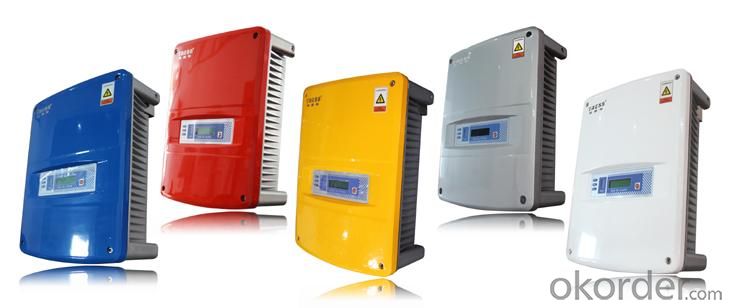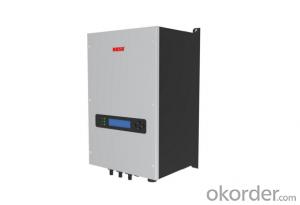Single Phase Inverter Second Generation 1k Solar Inverter made in China
- Loading Port:
- Shanghai
- Payment Terms:
- TT OR LC
- Min Order Qty:
- 0 watt
- Supply Capability:
- 10000 watt/month
OKorder Service Pledge
OKorder Financial Service
You Might Also Like
Description of Single Phase Inverter Second Generation Solar Inverter
Solar ac power system consists of solar panels, charge controllers, inverter and battery; Solar energy does not include inverter dc power system. Inverter is a kind of power conversion device, inverter by incentives can be divided into self-excited oscillation inverter and separately excited oscillation inverter.
Features of Single Phase Inverter Second Generation Solar Inverter
Standard 10 years warranty, 5-15 years optional
Built-in Gprs as option
Built-in Wifi as option
Smaller and lighter, only 9.6kg
High performance DSP for algorithm control
VDE-AR-N 4105 certification
New topology design
Dual MPPT design
Multi-button touch interface
LCD screen visible at night
Have anti-shading function
Advantages of Single Phase Inverter Second Generation Solar Inverter
Longer life cycle
Plug and play
Free monitoring through our webportal
Very lower internal temperature
Easy transportation and installation
Faster CPU speed
Adjustable active and reactive power
Maximum conversion effciency up to 97.7%,Euro up to 96.9%
Real-time data readable at night
User friendly operation
Technical Data of Single Phase Inverter Second Generation Solar Inverter
| Type | Omniksol-1k-TL2 |
| Input(DC) | |
| Max.PV Power | 1300W |
| Max,DC Voltage | 500V |
| Nominal DC Voltage | 360V |
| Operating MPPT Voltage Range | 80-360V |
| MPPT Voltage Range at Nominal Power | 150-360V |
| Start up DC Voltage | 90V |
| Turn off DC Voltage | 80V |
| Max, DC Current | 16A |
| Max, Short Cicuit Current for each MPPT | 20A |
| Number of MPP trackers | 1 |
| Number of DC Connection for each MPPT | 1 |
| DC Connection Type | MC4 connector |
| Output(AC) | |
| Max,AC Apparent Power | 1100VA |
| Nominal AC Power (cos phi = 1) | 1000W |
| Nominal Grid Voltage | 220V/230V/240V |
| Nominal Grid Frequency | 50Hz/60Hz |
| Max, AC Current | 5.8A |
| Grid Voltage Range** | 185-276V |
| Grid Frequency Range** | 45-55Hz/55-65Hz |
| Power Factor | 0.9 capacitive... 0.9 inductive |
| Total Harmonic Distortion(THD) | <2% |
| Feed in Starting Power | 30W |
| Night time Power Consumption | <1W |
| Standby Consumption | 6W |
| AC Connection Type | Plug-in connertor |
| Efficiency | |
| Max,Efficiency | 97.7% |
| Euro Efficiency | 96.7% |
| MPPT Efficiency | 99.9% |
| Safety and Protection | |
| DC Insulation Monitoring | Yes |
| DC Switch | Optional |
| Residual Current Monitoring Unit (RCMU) | Integrated |
| Grid Monitoring with Anti-islanding | Yes |
| Electricity Fuse Protection | Yes |
| Protection Class | Ⅰ(According to IEC 62103) |
| Overvoltage Category | PVⅡ/Mains Ⅲ(According to IEC 62109-1) |
| Reference Standard | |
| Safety Standard | EN 62109, AS/NZS 3100 |
| EMC Standard | EN 6100-6-1, EN 6100-6-2, EN 6100-6-3 EN 6100-6-4, EN 6100-3-2, EN 6100-3-3 |
| Grid Standard | VDE-AR-N4105. VDE-0126-1-1,G83/1,EN 50438,RD1699,CEI 0-21, AS4777,C10/C11 |
| Physical Structure | |
| Dimensions | 343x281x150mm |
| Weight | 9.6kg |
| Environmental Protection Rating | IP 65 (According to IEC 60529) |
| Cooling Concept | Natural convection |
| Mounting Information | Wall bracket |
| General Data | |
| Operating Temperature Range | -25℃ to +60℃(derating above 45℃) |
| Relative Humidity | 0% to 98%, no condensation |
| Max. Altitude (above sea level) | 2000m |
| Noise Type | <40dB |
| Isolation Type | Transformerless |
| Display | 3 LED ,Backlight, 4x20 Character LCD |
| Data Communication | RS485(WiFi, GRPS integrated) |
| Computer Communication | USB |
| Standard Warranty | 10 Years (5-15 years optional) |
IMages of Single Phase Inverter Second Generation Solar Inverter



FAQ
Q: Do you have the CE, TUV, UL Certification?
A: We’ve already passed all the tests, and any certificate is available.
Q: Have you ever sold your products to companies in my country?
A: Of course, we have customers in all general PV markets, but I think we should expand our market share along with the market growth.
Q: When did your company set up? You are a new company, how can I believe your quality?
A: We entered into Solar PV industry in 2005, now we have several plants in manufacturing of a-Si and c-Si panels, and our capacity is 220MW per year. Till now we have already passed all the tests by authorized laboratories, e.g. TUV, CE, UL.
Q: Can you help us install the module if we cooperate with you?
A: We haven’t entered into installation sector, but we have the plan in near future.
Q: How do you pack your products?
A: We have rich experience on how to pack the panels to make sure the safety on shipment when it arrives at the destination.
Q: Can you do OEM for us?
A: Yes, we can.
Q: Can we visit your factory?
A: Surely, I will arrange the trip basing on your business schedule.
- Q:How does a grid-tied solar inverter work?
- A grid-tied solar inverter works by converting the direct current (DC) electricity produced by solar panels into alternating current (AC) electricity that can be used to power homes or businesses. It synchronizes the AC electricity it generates with the electrical grid, allowing excess electricity to be sent back to the grid for credits or future use. This inverter also monitors the grid's voltage and frequency to ensure the solar system operates safely and efficiently.
- Q:What is the role of ground fault protection in a solar inverter?
- The role of ground fault protection in a solar inverter is to safeguard against electrical faults that occur when an unintended ground connection is made in the system. It detects any leakage of current to the ground and quickly disconnects the circuit to prevent the risk of electric shock or damage to the equipment. Ground fault protection ensures the safety and reliability of the solar inverter, as well as the overall solar power system.
- Q:What is the purpose of a solar inverter in a solar power system?
- The purpose of a solar inverter in a solar power system is to convert the direct current (DC) electricity produced by solar panels into alternating current (AC) electricity, which is the type of electricity used in most household appliances and the power grid.
- Q:What are the advantages of using a three-phase solar inverter?
- The advantages of using a three-phase solar inverter include higher efficiency, improved power quality, and the ability to handle larger loads. Three-phase inverters distribute the power generated by solar panels more evenly across all three phases, resulting in balanced power output and reduced losses. This leads to increased overall system efficiency. Additionally, three-phase inverters offer better power quality, minimizing voltage fluctuations and harmonics, which can be beneficial for sensitive electronic equipment. Lastly, these inverters are capable of handling larger electrical loads, making them suitable for commercial and industrial applications.
- Q:Can a solar inverter be used in extreme weather conditions?
- Yes, solar inverters are designed to withstand extreme weather conditions. They are typically built with durable materials and undergo rigorous testing to ensure they can operate in extreme temperatures, high humidity, and even harsh weather conditions such as heavy rain or snow. However, it is always recommended to consult the manufacturer's guidelines and take necessary precautions to protect the inverter during extreme weather events.
- Q:How do you calculate the payback period for a solar inverter?
- To calculate the payback period for a solar inverter, you need to determine the initial cost of the inverter and then calculate the annual savings or earnings generated by the inverter. Divide the initial cost by the annual savings to get the payback period, which is the time it takes to recoup the investment through savings or earnings.
- Q:How does the input power rating affect the performance of a solar inverter?
- The input power rating directly affects the performance of a solar inverter. A higher input power rating allows the inverter to handle larger amounts of power generated by the solar panels. This means that a higher input power rating can lead to better efficiency and performance of the solar inverter, as it can convert a greater amount of solar energy into usable electricity. Conversely, a lower input power rating may limit the inverter's capacity to handle high power outputs, potentially resulting in reduced efficiency and performance.
- Q:How does a solar inverter handle reactive power?
- A solar inverter handles reactive power by using power factor correction techniques. It actively manages the flow of reactive power between the solar panels and the grid, ensuring that the power factor remains close to unity. This helps to optimize the efficiency and performance of the solar system, while also maintaining the stability of the grid.
- Q:What is the lifespan of the capacitors in a solar inverter?
- The lifespan of capacitors in a solar inverter can vary depending on various factors, such as the quality of the components, operating conditions, and maintenance. Generally, high-quality capacitors can have a lifespan of around 10 to 15 years. However, it is important to regularly monitor and maintain the inverter to ensure optimal performance and longevity of the capacitors.
- Q:How does the efficiency of a solar inverter affect the overall system performance?
- The efficiency of a solar inverter plays a crucial role in determining the overall performance of a solar system. A higher efficiency inverter converts a greater percentage of the energy generated by the solar panels into usable electricity. This means that less energy is lost as heat, resulting in more electricity being available for consumption. A more efficient inverter translates into increased energy production, reduced reliance on grid power, and ultimately, higher cost savings. Additionally, a highly efficient inverter enhances the stability and reliability of the system, ensuring optimal performance and longevity.
1. Manufacturer Overview |
|
|---|---|
| Location | |
| Year Established | |
| Annual Output Value | |
| Main Markets | |
| Company Certifications | |
2. Manufacturer Certificates |
|
|---|---|
| a) Certification Name | |
| Range | |
| Reference | |
| Validity Period | |
3. Manufacturer Capability |
|
|---|---|
| a)Trade Capacity | |
| Nearest Port | |
| Export Percentage | |
| No.of Employees in Trade Department | |
| Language Spoken: | |
| b)Factory Information | |
| Factory Size: | |
| No. of Production Lines | |
| Contract Manufacturing | |
| Product Price Range | |
Send your message to us
Single Phase Inverter Second Generation 1k Solar Inverter made in China
- Loading Port:
- Shanghai
- Payment Terms:
- TT OR LC
- Min Order Qty:
- 0 watt
- Supply Capability:
- 10000 watt/month
OKorder Service Pledge
OKorder Financial Service
Similar products
New products
Hot products
Hot Searches
Related keywords































